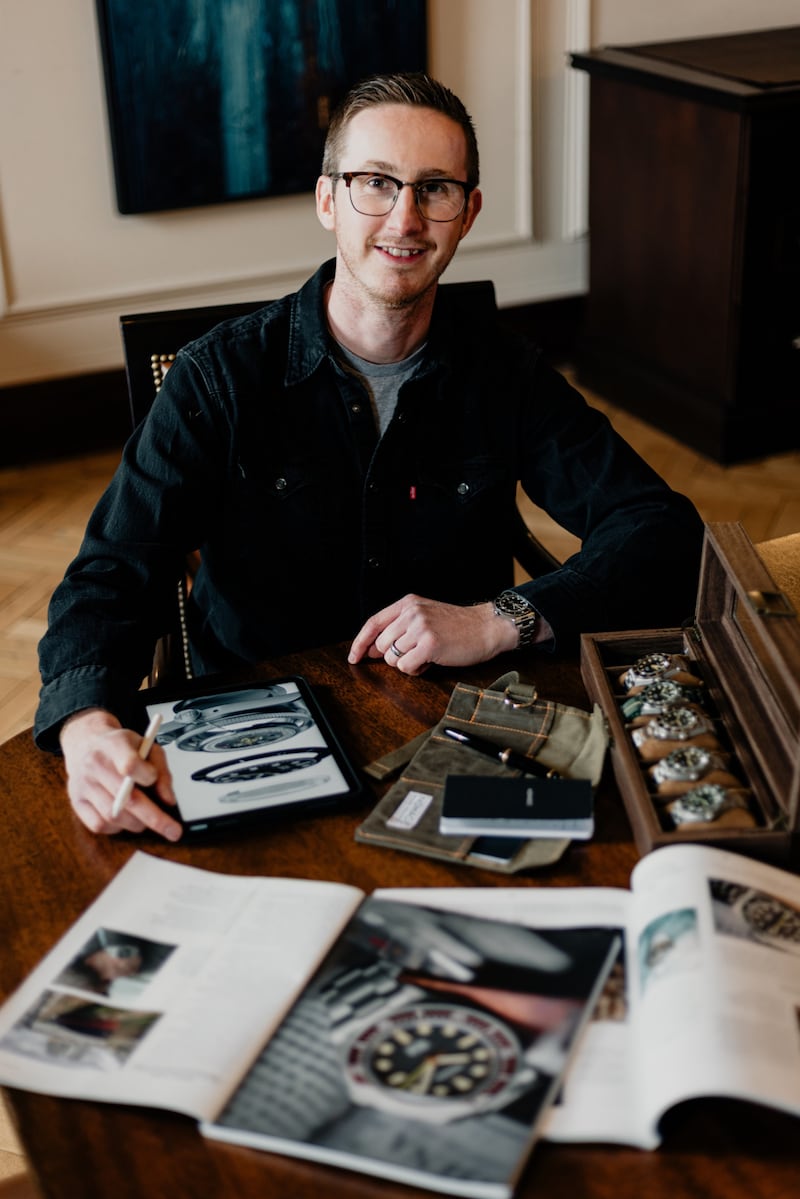To go from a tiny individual project in 2021, being worked on in a spare room of your house, to becoming a global brand, entering markets such as the United States, and being recognised by 10 Downing Street as one of the best current innovators of Northern Ireland is some journey to take.
Two years ago, I interviewed Nomadic Watches’ founder Peter McAuley in the bar at the Titanic Hotel in Belfast. He had a dream to create a beautiful, hand-assembled watch, designed and made in Belfast, that could take on Rolex and TAG Heuer and beat them at their own game while costing a fraction of the price of those Swiss grandees.
We’re sitting next to the company’s “factory shop”. The little retail space where we’re enjoying coffee and a chat is adjacent to a larger room next door where the manufacturing is taking place. But to call Nomadic’s current space a factory shop seems to be entirely the wrong end of the stick to grab.

Nomadic’s first watch paid homage to the Titanic, being called the Maraí (the Irish for seafarer) and bearing the serial number 401 – the same as the Titanic’s original design number
“We really got started around the idea of trying to make a watch that reflects Belfast, and which represents what we’re all about,” McAuley explains. “There are these great stories of adventure and industry from Belfast, and across the rest of Ireland, and I just felt that nobody was really telling these stories. And a watch, I think, always tells a story more than it tells time.”
READ MORE
Nomadic is named after a tender steamer that brought passengers out to the great ocean liners anchored offshore, a vessel that is now adjacent to, and part of, the famed Titanic Belfast museum. Nomadic’s first watch paid homage to the Titanic, being called the Maraí (the Irish for seafarer) and bearing the serial number 401 – the same as the Titanic’s original design number. It was also designed by McAuley, who often sketched and refined the look while sitting in the lobby of the Titanic Hotel, which was of course originally the drawing office for the Harland & Wolff shipyard. Almost without irony, considering the Titanic connection, that Maraí 401 is a diver’s watch.
For the second watch in the range, McAuley looked to the wider island, to Kerry and to Tom Crean.
Crean famously joined two Antarctic expeditions, first with the doomed Robert Falcon Scott, and then with Ernest Shackleton, a Kildare man let’s not forget.
Nomadic’s second watch, then, would be the Turas 914, which celebrated the doughty achievements of Crean and Shackleton in sailing to Antarctica, losing their ship to crushing ice, and then covering 1,300km of open, frozen ocean to seek help, losing not a single life among the crew in the process. It seems perfectly timed that, not long after Nomadic launched the watch, Shackleton’s ship, the Endurance, was found on the floor of the Antarctic Sea, perfectly preserved by the deep-freeze water.
“It’s one of the greatest survival stories ever told,” McAuley says. “It is really inspiring and it just goes to show you what can be done through incredibly difficult circumstances.”
While Shackleton and Crean did well to survive in the face of such literal and figurative headwinds, the modern-day retail sector could do with a bit of the same fortitude. Across Ireland, the boarded-up shop fronts are multiplying, and the retreat of the big UK retailers – the likes of Debenhams, Argos, and Iceland – has become something of a rout in the face of increasing costs and the juggernaut that is Amazon, not to mention the effect of Brexit on the UK multinationals.
You’d think that Nomadic – which started as a strictly online retailer – would be inclinded to join the withdrawal but, as McAuley points out, the reverse is the case. “A lot of businesses are retreating from the high street,” he says. “Mix that in with the cost-of-living crisis, and a lot of people were telling us that we were pretty crazy to be setting up a luxury watch boutique in the middle of Belfast. But I think people want more from the retail experience than just going in and buying.”
Without naming names, we’ve definitely noticed a few competitors who have seen what we’re doing, and have now started to change what they’re doing to combat us a little bit
At the moment, Nomadic is offering something quite different from the traditional retail experience. You can’t just wander in off the street – you have to book an appointment, and then turn up at the Scottish Provident building just opposite Belfast’s City Hall. You’re then met and brought to the Nomadic boutique, which is small enough that four people would be a crowd. Here you can try on the various watches and straps and, if you’ve ordered a watch, you can pop next door to see master watchmaker Michael minutely mating the Swiss-made automatic movements with the stainless-steel cases.
“It was always our plan to move away from the online-only model,” says McAuley. “I definitely see our next step as something a bit more public-facing, evolving into a full, traditional shopfront, as well as moving into retail spaces around the world – the likes of London, San Diego and New York. We have lots of customers in those locations.”

Recently, the brand launched its third and fourth watches – a Fior 555 GMT watch that can tell time in two time zones simultaneously, and a smaller Cíor 928 designed for women, and inspired directly, says McAuley, by his mother. He wanted to make a unique watch just for her.
Since it began, Nomadic has grown from McAuley’s home to becoming the best-selling luxury watch brand in Ireland, and one of the fastest-growing in the UK. Such custom is getting Nomadic noticed in high places. McAuley recently received an invitation to tea with British prime minister Keir Starmer.
“That was a pretty amazing experience. He wanted me to have tea with my other great personal friend, Naomi Campbell,” says McAuley with a chuckle. “So that was part of London Fashion Week’s 40th anniversary celebrations. It was pretty incredible when I actually got the invite through, which came late at night, as an email from someone I’d never heard of. I thought, this is obviously a scam.
“But we did some research, and it turned out it was absolutely legit. So we turned up at Number 10, and the room was just filled with everyone from the fashion world. A who’s who of everyone in fashion, all these amazing designers, and half of them, I did not have a clue who they were. I was definitely a fish out of water. But it was great to be representing Northern Ireland and Belfast on that stage. And for us as watchmakers, I like to think of us as that intersection between art and fashion and engineering.”
Currently, Nomadic makes around 1,500 watches annually – small beer compared to the likes of Omega, TAG Heuer, or Rolex but those big brands are starting to take notice of Nomadic. “Without naming names, we’ve definitely noticed a few competitors who have seen what we’re doing, and have now started to change what they’re doing to combat us a little bit. We’re just doing our own thing, and staying true to what we want to achieve, but it’s somewhat flattering to see some of the other brands copying us in little ways” McAuley says.
Most of Nomadic’s range costs between €1,000 and €1,500 – not cheap, certainly, but a fraction of what an equivalent Rolex would cost. And there is an equivalency – I would defy anyone to find a gap in the quality or style of one of McAuley’s watches compared to the big Swiss brands.

In fact, as McAuley notes, the likes of Rolex can actually make their watches – using similar automatic movements and the same 316L grade stainless steel – at a lower cost base, simply because their purchasing base is so huge. His final product prices are lower, though, because he sells directly to the consumer, cutting out the jewellery retailers.
Will that change as Nomadic expands into more general retail? Hopefully not, but what will change is that you’ll be able to go from clicking and posting, to making a private appointment, to one day walking past a glittering, enticing shop window.
Is it asking too much for a small brand like Nomadic to kick-start a high street revival? Probably, but then watchmaking has a history of Lazarus-like comebacks. Back in the 1970s, as the Japanese quartz watch revolution swept the horological world, it looked as if the big Swiss names were all pretty much doomed. But they changed tack, reinvented, and are now not merely sellable, but desirable and collectable, too.
Who’s to say Nomadic, and other independent brands, can’t pull off a similar coup now?
- Sign up for Business push alerts and have the best news, analysis and comment delivered directly to your phone
- Find The Irish Times on WhatsApp and stay up to date
- Our Inside Business podcast is published weekly - Find the latest episode here





















